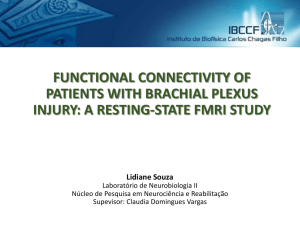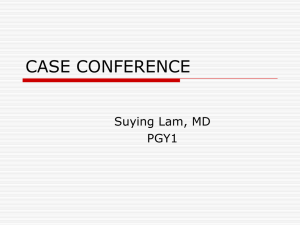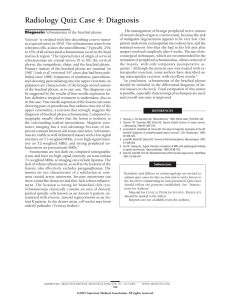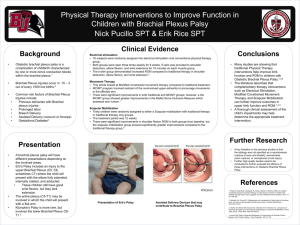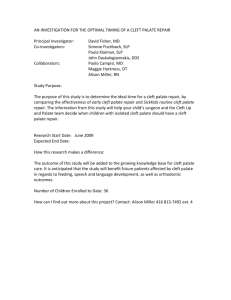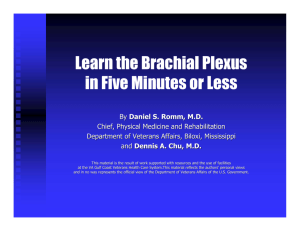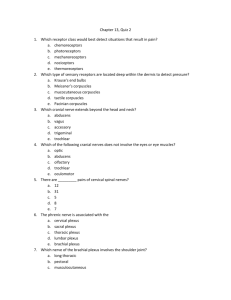Title Name(s)
advertisement
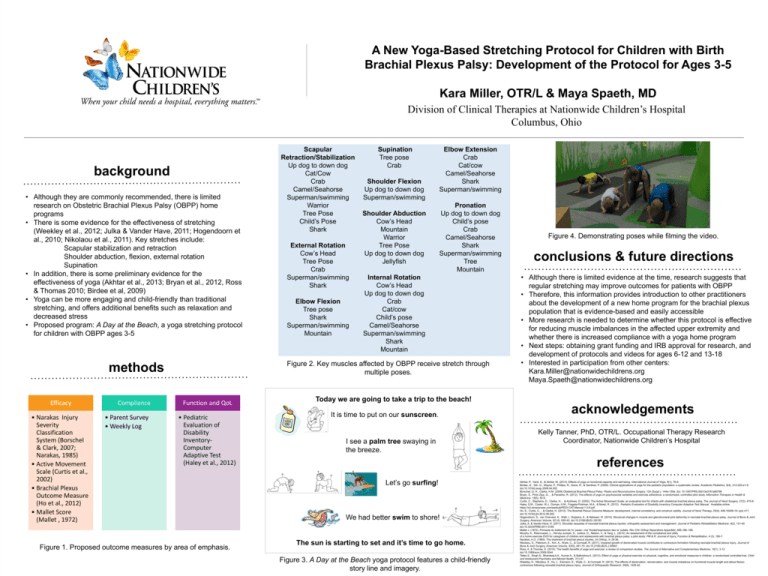
A New Yoga-Based Stretching Protocol for Children with Birth Brachial Plexus Palsy: Development of the Protocol for Ages 3-5 Kara Miller, OTR/L & Maya Spaeth, MD Division of Clinical Therapies at Nationwide Children’s Hospital Columbus, Ohio background • Although they are commonly recommended, there is limited research on Obstetric Brachial Plexus Palsy (OBPP) home programs • There is some evidence for the effectiveness of stretching (Weekley et al., 2012; Julka & Vander Have, 2011; Hogendoorn et al., 2010; Nikolaou et al., 2011). Key stretches include: Scapular stabilization and retraction Shoulder abduction, flexion, external rotation Supination • In addition, there is some preliminary evidence for the effectiveness of yoga (Akhtar et al., 2013; Bryan et al., 2012, Ross & Thomas 2010; Birdee et al, 2009) • Yoga can be more engaging and child-friendly than traditional stretching, and offers additional benefits such as relaxation and decreased stress • Proposed program: A Day at the Beach, a yoga stretching protocol for children with OBPP ages 3-5 methods Efficacy • Narakas Injury Severity Classification System (Borschel & Clark, 2007; Narakas, 1985) • Active Movement Scale (Curtis et al., 2002) • Brachial Plexus Outcome Measure (Ho et al., 2012) • Mallet Score (Mallet , 1972) Compliance • Parent Survey • Weekly Log Scapular Retraction/Stabilization Up dog to down dog Cat/Cow Crab Camel/Seahorse Superman/swimming Warrior Tree Pose Child’s Pose Shark External Rotation Cow’s Head Tree Pose Crab Superman/swimming Shark Elbow Flexion Tree pose Shark Superman/swimming Mountain Supination Tree pose Crab Shoulder Flexion Up dog to down dog Superman/swimming Shoulder Abduction Cow’s Head Mountain Warrior Tree Pose Up dog to down dog Jellyfish Elbow Extension Crab Cat/cow Camel/Seahorse Shark Superman/swimming Pronation Up dog to down dog Child’s pose Crab Camel/Seahorse Shark Superman/swimming Tree Mountain Internal Rotation Cow’s Head Up dog to down dog Crab Cat/cow Child’s pose Camel/Seahorse Superman/swimming Shark Mountain Figure 2. Key muscles affected by OBPP receive stretch through multiple poses. Function and QoL • Pediatric Evaluation of Disability InventoryComputer Adaptive Test (Haley et al., 2012) Figure 1. Proposed outcome measures by area of emphasis. Today we are going to take a trip to the beach! It is time to put on our sunscreen. I see a palm tree swaying in the breeze. Figure 4. Demonstrating poses while filming the video. conclusions & future directions • Although there is limited evidence at the time, research suggests that regular stretching may improve outcomes for patients with OBPP • Therefore, this information provides introduction to other practitioners about the development of a new home program for the brachial plexus population that is evidence-based and easily accessible • More research is needed to determine whether this protocol is effective for reducing muscle imbalances in the affected upper extremity and whether there is increased compliance with a yoga home program • Next steps: obtaining grant funding and IRB approval for research, and development of protocols and videos for ages 6-12 and 13-18 • Interested in participation from other centers: Kara.Miller@nationwidechildrens.org Maya.Spaeth@nationwidechildrens.org acknowledgements Kelly Tanner, PhD, OTR/L. Occupational Therapy Research Coordinator, Nationwide Children’s Hospital references Let’s go surfing! We had better swim to shore! The sun is starting to set and it’s time to go home. Figure 3. A Day at the Beach yoga protocol features a child-friendly story line and imagery. Akhtar, P., Yardi, S., & Akhtar, M. (2013). Effects of yoga on functional capacity and well being. International Journal of Yoga, 6(1), 76-9. Birdee, G., Yeh, G., Wayne, P., Phillips, R., Davis, R., & Gardiner, P. (2009). Clinical applications of yoga for the pediatric population: a systematic review. Academic Pediatrics, 9(4), 212-220.e1-9. doi:10.1016/j.acap.2009.04.002 Borschel, G. H., Clarke, H.M. (2009) Obstetrical Brachial Plexus Palsy. Plastic and Reconstructive Surgery. 124 (Suppl.): 144e-155e. doi: 10.1097/PRS.0b013e3181a80798 Bryan, S., Pinto Zipp, G., , & Parasher, R. (2012). The effects of yoga on psychosocial variables and exercise adherence: a randomized, controlled pilot study. Alternative Therapies in Health & Medicine, 18(5), 50-9. Curtis, C., Stephens, D., Clarke, H., , & Andrews, D. (2002). The Active Movement Scale: an evaluative tool for infants with obstetrical brachial plexus palsy. The Journal of Hand Surgery, 27(3), 470-8. Haley, S.M., Coster, W.J., Dumas, H.M., Fragala-Pinkman, M.A., & Moed, R. (2012). Pediatric Evaluation of Disability Inventory Computer Adaptive Test Manual. Available online: https://s3.amazonaws.com/pedicat/PEDI-CAT-Manual-1-3-6.pdf. Ho, E., Curtis, C., , & Clarke, H. (2012). The Brachial Plexus Outcome Measure: development, internal consistency, and construct validity. Journal of Hand Therapy, 25(4), 406-16406-16; quiz 417. doi:10.1016/j.jht.2012.05.002 Hogendoorn, S., van Overvest, K., Watt, I., Duijsens, A., & Nelissen, R. (2010). Structural changes in muscle and glenohumeral joint deformity in neonatal brachial plexus palsy. Journal of Bone & Joint Surgery, American Volume, 92 (4), 935-42. doi:10.2106/JBJS.I.00193 Julka, A. & Vander Have, K. (2011). Shoulder sequelae of neonatal brachial plexus injuries: orthopedic assessment and management. Journal of Pediatric Rehabilitation Medicine, 4(2), 131-40. doi:10.3233/PRM-2011-0165 Mallet J. (1972). Primaute du traitement de l’e´paule—me´thoded’expression des re´sultats. Rev Chir Orthop Reparatrice ApparMot, 58S,166–168. Murphy, K., Rasmussen, L., Hervey-Jumper, S., Justice, D., Nelson, V., & Yang, L. (2012). An assessment of the compliance and utility of a home exercise DVD for caregivers of children and adolescents with brachial plexus palsy: a pilot study. PM & R: Journal of Injury, Function & Rehabilitation, 4 (3), 190-7. Narakas, A.O. (1985). The treatment of brachial plexus injuries. Int Orthop, 9. 29-36. Nikolaou, S., Peterson, E., Kim, A., Wylie, C., & Cornwall, R. (2011). Impaired growth of denervated muscle contributes to contracture formation following neonatal brachial plexus injury. Journal of Bone & Joint Surgery, American Volume, 93(5), 461-70. doi:10.2106/JBJS.J.00943 Ross, A. & Thomas, S. (2010). The health benefits of yoga and exercise: a review of comparison studies. The Journal of Alternative and Complementary Medicine, 16(1), 3-12. doi:10.1089/acm.2009.0044 Telles S., Singh N., Bhardwaj A.K., Kumar A., & Balkrishna A. (2013). Effect of yoga or physical exercise on physical, cognitive, and emotional measures in children: a randomized controlled trial. Child and Adolescent Psychiatry and Mental Health, 7(1):37. Weekley, H., Nikolaou, S., Hu, L., Eismann, E., Wylie, C., & Cornwall, R. (2012). The effects of denervation, reinnervation, and muscle imbalance on functional muscle length and elbow flexion contracture following neonatal brachial plexus injury. Journal of Orthopaedic Research, 30(8), 1335-42.

